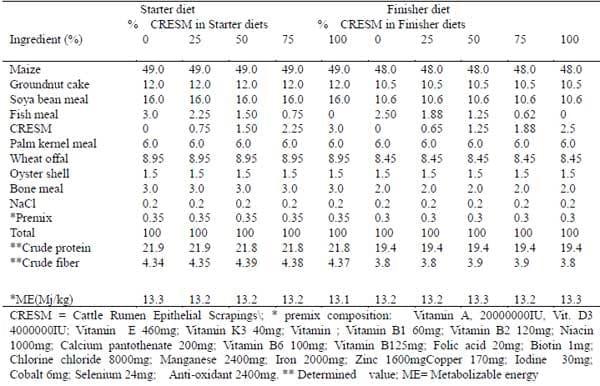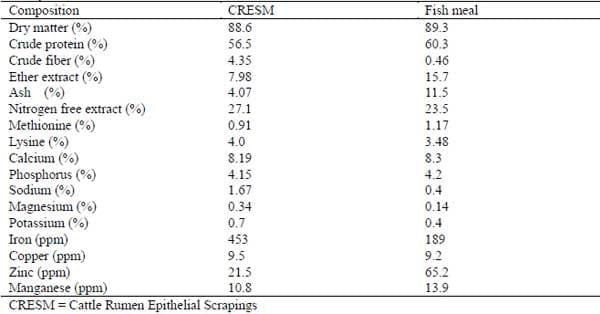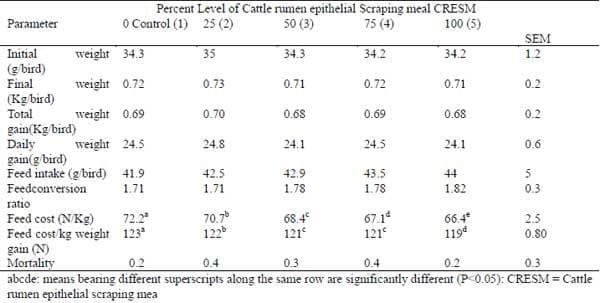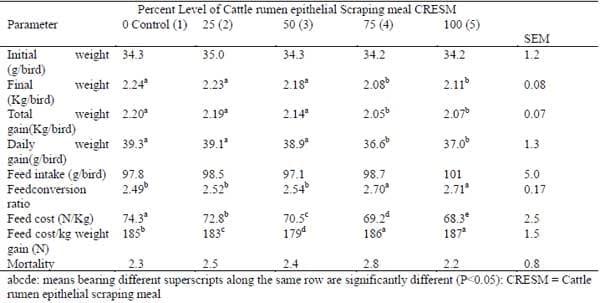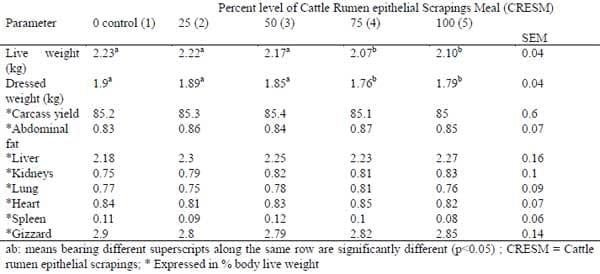1. Introduction
Feed cost constitutes about 80% the total cost of intensive livestock production. This has been linked to high cost of protein ingredients which often constitute a substantial proportion in the diet (Ojewola and Annah, 2006). Fish meal is the conventional and major source of animal protein in livestock feed. Unfortunately however, fish meal is one of the most expensive ingredients that constitute substantial part of poultry ration. This is due to the fact that it is not produced in sufficient quantity in most countries of the world and has to be imported with foreign currency. The progressive increase witnessed in the price of fish meal in the recent past years has led to the search for alternative protein sources in livestock feeds. Unconventional protein sources that have been investigated include grass hopper (Rosenfeld et al., 1997), cray fish dust (Ojewola and Annah, 2006), maggot meal (Sogbesan et al., 2006), earth worm meal (Reinecke et al., 1991), hatchery waste (Handa et al., 1996) and cattle rumen epithelial scrapings meal.
Cattle rumen epithelial scraping is the by-product of processing of cattle rumen into edible meat which is highly relished in most African countries. It is the thin layer of the rumen that is scraped off during the cleaning of this organ for food by man. The potential of cattle rumen epithelial scraping for goat has been explored (Bawala and Akinsoyinu, 2006; Bawala et al., 2007 and Ogunwole, 2011). Moreover, cattle rumen epithelial scraping meal pose no health hazard to livestock animal and man as its microbial load has been reported to be within acceptable range of total plate count of dry ready to eat food (Alikwe et al., 2005a). Available data on the utilization of cattle rumen epithelial scraping by broiler chicken is confusing. While it was reported that it can better replace fish meal during the starter phase, it was found to be inferior to fish meal at the finishing phase (Alikwe et al., 2005b). The present study was therefore conducted to remove this confusion . The use of cattle rumen epithelial scrapings meal for poultry can be a way of reducing the cost of feed as well as solving the problem of environmental pollution in urban centers.
2. Materials and methods
2.1 Experimental site
The study was conducted at the brooder house of the Poultry Unit, Teaching and Research Farm, Ladoke Akintola University of Technology, Ogbomoso, Oyo State , Nigeria. The study fall between latitudes 8º07’N and 8º12’N and longitudes 4º04’E and 4º15’E. The mean annual rainfall is 1247mm with relative humidity of between 75 and 95%. The location is situated at about 500m above the sea level with a mean annual temperatur e of 26.2ºC.
2.2 Source and preparation of test ingredient
Cattle rumen epithelial scrapings were collected from Bodija abattoir, Ibadan, Oyo State, Nigeria. This was then immersed in boiling water (100ºC) for 30 minutes after which it was drained of water and sundried for 7 days in an intense sunshine (February sun) until it was about 13% moisture content. The dried product was ground to obtain what was called Cattle Rumen Epithelial Scrapings Meal (CRESM).
2.3 Feeds and diet preparation
Five diets were formulated at both starter and finisher phases. Control broiler starter were formulated to contain 21.7% crude protein and 2.8Kcal/g metabolizable energy while control finisher diet was formulated to contain 19.4% crude protein and 13.8Mj/kg metabolizable energy. Cattle rumen epithelial scrapings meal was then used to replace 25, 50, 75 and 100% fish meal in the control diets. The gross composition of the diets is shown in Table 1. Danish fish meal was purchased from a local feed miller within Ogbomoso township.
2.4 Birds and their management
Two hundred and fiftyday-old broiler chicks of Ross strain average 34±1.2g were purchased from Nu- breed Farm, Abeokuta, Ogun State, Nigeria.The birds were randomly divided into five equal groups of 50 birds each and the groups allotted to five dietary treatments in a completely randomized design. Each treatment was replicated 5 times. Birds were housed in deep litter pen measuring 1.2x1m with the floor littered with wood shaven. Feeds and water were offered without restriction. Birds were vaccinated and medicated against Newcastle disease, Infectious bursa disease, coccidiosis and fowl typhoid. Medication and vaccination were carried out according to the approved programme for Ogbomoso area. Birds were fed starter diets for the first 4 weeks and finisher diets for the remaining four weeks. The study lasted for 8 weeks.
2.5 Data collection
Data were collected on feed intake, weight gain, feed:gain ratio, mortality, feed cost and feed cost per kilogram weight gain. Feed intake was calculated as the feed offered minus left over the following morning. Weight gain was calculated as the difference in the weight of the birds in two successive weeks. Feed: gain ratio was determined as feed intake divided by weight gain.
Mortality record was taken from the beginning of the experiment to the end and expressed as the percentage of the total birds in a pen at the beginning of the experiment. Feed cost was calculated from the unit prices of the ingredients used in feed preparation. Unit price of cattle rumen epithelial scrapings meal was determined from the cost of transportation, labour and energy used in boiling. Feed cost per kilogram weight gain was determined from feed cost and feed:gain ratio.
2.6 Metabolic studies
Ten birds that had their weights close to the average for the groups were selected from each treatment for metabolic studies at the end of the trial (2 birds/replicate). Birds were housed in groups in five metabolic cages with facilities for feeding drinking and faecal collection. Birds were allowed 5 days pre-collection period followed which the faeces were collected for 3 days using total collection method. Faeces collected were oven-dried at 70ºC for 48 hrs until they attained 13% moisture content. Faeces were then bulked and representative samples collected for laboratory analysis. Nutrient utilized was calculated from the results of feeds and faecal analysis using the formula:
2.7 Carcass evaluation
Also ten birds that were close to the average of the groups were also selected from each treatment, fasted for 24hrs in readiness for carcass evaluation. The birds were wing bound, weighed individually, stunned, bled, immersed in hot water (80ºC), cleaned of feather and dressed. Internal organs (liver, kidney, lung, heart, spleen and gizzard were also excised clean of blood and weighed. The weights obtained were then expressed as the percentage of the live weight of the birds. Abdominal fat was also carefully scraped off, weighed and expressed as a percentage of the live weight of the birds.
2.8 Biochemical analysis
Dry matter, crude protein, crude fiber, ether extract, ash and nitrogen free extract fractios of the CRETSM and fish meal were determined using the methods of AOAC (1990). Calcium, magnesium, manganese and iron were determined using Perkin-Elmer Model 2380 atomic absorption spectro-photometer after wet digestion of the sample. Phosphorus was determined using a spectrophotometric phosphoammonium vanadate reaction as described by Chapman and Pratt (1961). Sodium and potassium were determined in the ash solution by emission spectroscopy at 589.0 nm and 766.5nm respectively using acetylene gas flame (AOAC, 1995). Zinc was determined by atomic absorption spectroscopy using single element hollow cathode lamps and acetylene gas flame.
Methionine and lysine contents of CRESM and fish meal were determined using liquid cromatography technique as described by Ijarotimi and Olopade (2009). Methionine and lysine contents of CRESM and fish meal were determined using liquid chromatography technique as described by Ijarotimi and Olopade (2009).
2.9 Statistical analysis
Data analysis was carried out by one way analysis of variance using General Linear Model procedure of SAS (SAS, 1998). Significance was determined at P<0.05) and where significance were indicated, Duncan’s option of the same software was used to separate the means.
3.Results
The result of the chemical analysis of the CRESM and fish meal used in the study is shown in Table 2. The protein content of CRESM is close to but slightly lower than that of fish meal (56.52% CP Vs 60.34% CP). Fish meal is slightly superior to CRESM with respect to methionine (1.17% Vs 0.91%) while CRESM is slightly superior to fish meal with respect to lysine (4.0% V s 3.48%). Cattle rumen epithelial scrapings meal contained higher concentration of sodium (1.69% Vs 0.4%), magnesium (0.34% Vs 0.14%) , potassium (0.70% Vs0.4% and iron (453 ppm Vs 189 ppm) than fish meal.
The performance and economic implication of substituting CRESM for fish meal in broiler diet in the starter phase is presented in Table 3. Dietary treatment had no significant (p>0.05) effect on weight gain, feed intake, feed conversion ratio and mortality. Feed cost and feed cost per kilogram weight gain however reduced (p<0.05) with increase level of CRESM substitution for fish meal in the diets. Birds that were fed fish meal as the only source of animal protein had the highest feed cost and feed cost/ kg weight gain than others.
The performance and economic implication of replacing fish meal with CRESM at the finishing phase is shown in Table 4. No significant difference was observed in final weight, total weight gain and daily weight gain of the control group and those that had 25% and 5 0% fish meal in their diet replaced with CRESM. However, significant (p<0.05) depression was observed in these parameters at 75 and 100 percent levels of substitution. Feed intake of the birds was not affected by dietary treatments. Feed utilization by the birds that had 75 and 100 percent fish meal in their diets replaced was poor as reflected by their higher (P<0.05) feed to gain ratio.
Feed cost also reduced (P<0.05) progressively with increased level of CRESM substitution in the diet at the finisher phase. Feed cost per kilogram weight gain was significantly (P<0.05) different among the treatments. Highest cost was observed on birds that were fed 100% CRESM as the main source of animal protein, followed by 75%, 0%, 25% and 50% in that order. No significant effect of diet was observed on mortality.
The nutrient utilization of the broiler chicken fed CRESM in replacement for fish meal is shown in Table 4. Utilization of dry matter, crude protein and nitrogen free extract was not significantl y different at 0, 25 and 50 percent substitution but was significantly (P<0.05) depressed at 75 and 100 percent replacement level. Crude fiber was better utilized by birds that had only fish meal as main source of animal protein in their diet. No significant difference was however observed in the utilization of ether extract by the birds.
The carcass characteristics and organ weights of the birds are shown in Table 5. The live weight and dressed weight of the birds were significantly (P<0.05) affected by dietary treatments. Final live weight and dressed weight of birds that had 25% and 50% fish meal in their diets replaced were similar to that of the control. These were however higher than the values observed for those that had 75 and 100% fish meal in their diets replaced. No significant difference was observed in carcass yield and weights of abdominal fat, liver, kidneys, lung, heart, spleen and gizzard of the birds.
4. Discussion
The fact that CRESM is rich in protein, methionine and lysine makes it a potential animal protein source for livestock animal most especially monogastic animals. The protein content off cattle rumen epithelial tissue scrapings meal used in this study is slightly higher than that reported by Alikwe et al (2005a) but lower than that reported by Bawala et al (2007) and Isah and Babayemi (2010). This difference could be due to the technique used in scrapings or processing method or the age of the animals from which the tissues scrapings were collected.
This study revealed that complete replacement of fish meal with CRESM had no adverse effect on feed intake, growth, feed conversion and mortality at the starter phase. This implies that CRESM can successfully replace fish meal in broiler starter diet at this phase without compromising the growth performance. Alikwe et al (2005b) earlier reported that broilers fed cattle rumen epithelial wastes meal in the starter phase were heavier than those fed only fish meal as a major source of animal protein.
Cost of feed reduced gradually with increase level of fish meal substitution with CRESM in both starter and finisher diets. This is a direct consequence of lower price of fish meal compared to CRESM which was a waste. The implication of this is that more profit can be made by replacing fish meal with CRESM during the starter phase.
This study revealed that growth rate , final live weight and dressed weight were depressed at 75% and 100% level of fish meal substitution by CRESM at the finisher phase. This can be attributed to poor nutrient utilization probably occasioned by amino acid imbalance. Rumen epithelium scrapings consists of mainly papillae layer which is made up of core of densely packed collagen fibers surrounded by stratified epithelium similar to the papillary bodies in skin. The cumulative effects of this poor quality protein on the birds could have had a dverse effect on the growth performance of the birds at higher le vel of substitution during the finishing phase.
The higher cost of poultry meat production that was observed on birds that were fed solely on fish meal as main source of animal protein can be attributed to higher cost of fish meal compared to CRESM.
5. Conclusion
The results of this study show that CRESM has nutritional benefits for broiler chicken and can completely replace fish meal in broiler starter diet. It can also replace 50% fish meal in broiler finisher diet. Recycling CRESM by substituting it for fish meal in broiler diets assists in feed cost reduction and can also be a way of solving the problem of environmental pollution.
6. Acknowledgement
The authors wish to appreciate Dr Togun V.A. The farm Director and the entire staff of Teaching and Research Farm Ladoke Akintola University of Technology, Ogbomoso for their technical support during the period of the study.
References
A O A C. (1990). Official methods of analysis 15th ed. Association of Official Analytical C hemist, Washington D.C. A O A C. (1995). The official methods of analysis. Association of Official Analytical Chemists (16th edition). Arlington. A.O.A.C. International.
Alikwe, P. C. N., Akinsoyinu, A. O ., Ogunwole, O. A. and Babatunde, E. B. (2005a ). Effects of processing on gastro microbial content of broilers finishers fed rumen epithelial scrapings meal based diets. Proc. 10th Ann. Conf. Animal Science Association of Nigeria, University of Ado Ekiti, Nigeria. Sept. 12-15,200 5, Pp163-166.
Alikwe, P. C. N., Akinsoyinu, A. O., Babatunde, E. B and Ogunwole, O. A. (2005b). The replacement value of rumen epithelial scrapping meal (RESM) for fish meal in the broilers. Tropical Journal of Animal Science Vol. 8 (1):69-75.
Bawala, T. O. and Akinsoyinu, A. O. ( 2006). Nutritional evaluation of rumen epith elial tissue scrapings in goat nutrition. Nutrition and Food Science Vol. 36 (6):414-418
Chapman, H. and Pratt. E. F. (1961). Methods of analysis of soil plant and water. University of Califonia. Division of Agricultural Sciences. Davis C.A. U.S.A.
Handa, M. C., Sapra K. L. and Shingari, B. K (1996). Effect of feeding extruded hatchery waste on the performance of Soviet Chinchilla rabbits. World Rabbit Science 4(2):89-92.
Ijarotimi, O. S. and Olopade, A. J. (2009). Determination of amino acid content and prote n quality ofcomplementary food produced from locally available food materials in Ondo State, Nigeria, Malaysian. Journal of Nutrition. 15 (1): 87-95.
Isa, O. A. and Babayemi, O. J (201 0). Nutrient degradability and performance by the West African Dwarf Goat fed rumen epithelium-baseddiets. Jour nal of Agriculture Science Technology. Vol. 12:289-297.
Ogunwole, O. A. (2011). Degradation of organic matter in groundnut cake, Panicum maximum and rumen epithelial scraping based diets by West African Dwarf Sheep. International Journal of Current Research and Review Vol. 3 (8):9-16.
Ojewola, G. S. andAnnah, S. I. (2006). Nutritive and economic value of Danish fish m eal, crayfish dust meal and shrimp waste meal inclusion in broiler diets. International Journal of Poultry Science, 5(4):390-394.
Reinecke, A. J., Hayes J. P. and Cilliers, S. C (1991). Protein quality of three different species of earth worms. South African Journal of Animal Science. 21 (2):99-103.
Rosenfeld, D. J., Gernat Marcano, J. D., Murillo, J. G., Lopez G. H. and Flores, J. A. (1997).The effect of using different levels of shrimp waste meal in broiler diets. Poultry. Science, 78:581-586.
SAS Institute. (1998). SAS User’s G uide Statistic 1998 edition. SAS institute, Inc. North Carolina.
Sogbesan, A. O., Ajuonu, N., Musa B. O. and Adewole, A.M (2006). Harvesting techniques and evaluation of maggot meal as animal dietary protein source for ‘Heteoclarias’ in indoor concrete tanks. World Journal of Agricultural Sciences 2 (4): 394-402.
Table 1. Gross Composition of Expe rimental diets.
Table 2. Proximate composition (Dry matter basis), animo acid content and mineral composition of Cattle Rumen Epithelial Tissue Scrapings and Fish meal used in the study.
Table 3: Growth performance and economic implication of feeding CRESM based diets to broiler chicken at starter phase
Table 4: Growth performance and economic implication of feeding CRESM based diets to broiler till finisher phase.
Table 5: Nutrient Utilization of the b roiler chicken fed CRESM in replacement for fish meal.
Table 6: Carcass characteristics and organ weight of broilers fed CRESM based diet.
